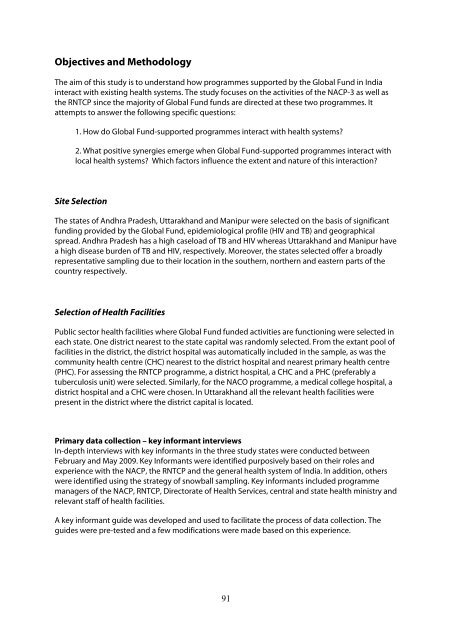MAXIMIZING POSITIVE SYNERGIES - World Health Organization
MAXIMIZING POSITIVE SYNERGIES - World Health Organization
MAXIMIZING POSITIVE SYNERGIES - World Health Organization
You also want an ePaper? Increase the reach of your titles
YUMPU automatically turns print PDFs into web optimized ePapers that Google loves.
Objectives and Methodology<br />
The aim of this study is to understand how programmes supported by the Global Fund in India<br />
interact with existing health systems. The study focuses on the activities of the NACP-3 as well as<br />
the RNTCP since the majority of Global Fund funds are directed at these two programmes. It<br />
attempts to answer the following specific questions:<br />
1. How do Global Fund-supported programmes interact with health systems?<br />
2. What positive synergies emerge when Global Fund-supported programmes interact with<br />
local health systems? Which factors influence the extent and nature of this interaction?<br />
Site Selection<br />
The states of Andhra Pradesh, Uttarakhand and Manipur were selected on the basis of significant<br />
funding provided by the Global Fund, epidemiological profile (HIV and TB) and geographical<br />
spread. Andhra Pradesh has a high caseload of TB and HIV whereas Uttarakhand and Manipur have<br />
a high disease burden of TB and HIV, respectively. Moreover, the states selected offer a broadly<br />
representative sampling due to their location in the southern, northern and eastern parts of the<br />
country respectively.<br />
Selection of <strong>Health</strong> Facilities<br />
Public sector health facilities where Global Fund funded activities are functioning were selected in<br />
each state. One district nearest to the state capital was randomly selected. From the extant pool of<br />
facilities in the district, the district hospital was automatically included in the sample, as was the<br />
community health centre (CHC) nearest to the district hospital and nearest primary health centre<br />
(PHC). For assessing the RNTCP programme, a district hospital, a CHC and a PHC (preferably a<br />
tuberculosis unit) were selected. Similarly, for the NACO programme, a medical college hospital, a<br />
district hospital and a CHC were chosen. In Uttarakhand all the relevant health facilities were<br />
present in the district where the district capital is located.<br />
Primary data collection – key informant interviews<br />
In-depth interviews with key informants in the three study states were conducted between<br />
February and May 2009. Key Informants were identified purposively based on their roles and<br />
experience with the NACP, the RNTCP and the general health system of India. In addition, others<br />
were identified using the strategy of snowball sampling. Key informants included programme<br />
managers of the NACP, RNTCP, Directorate of <strong>Health</strong> Services, central and state health ministry and<br />
relevant staff of health facilities.<br />
A key informant guide was developed and used to facilitate the process of data collection. The<br />
guides were pre-tested and a few modifications were made based on this experience.<br />
91

















